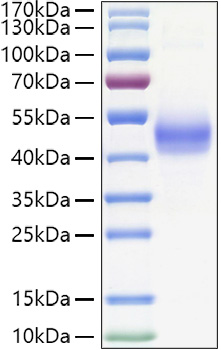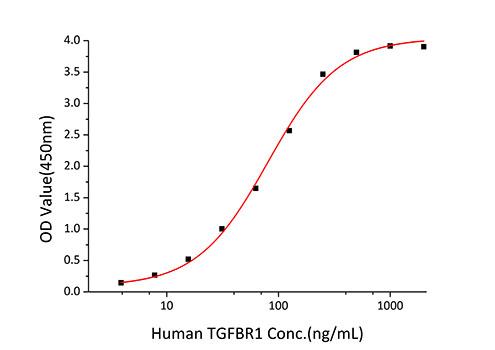Description
Recombinant Human TGFR-1/ALK-5 Protein
The Recombinant Human TGFR-1/ALK-5 Protein is a biologically active recombinant protein that plays a significant role in various cellular processes and signaling pathways in human biology. This protein is widely employed in immunological research, cell biology studies, protein-protein interaction analyses, and therapeutic development, providing researchers with a reliable tool for investigating TGFR-1/ALK-5 function and its implications in health and disease.
This product (SKU: RPCB1424) is produced using HEK293 cells and features a C-hFc&His tag for convenient detection and purification. The protein exhibits a calculated molecular weight of 39.90 kDa with an observed molecular weight of 40-55 kDa under denaturing conditions, achieving ≥ 95 % as determined by SDS-PAGE.. Functional bioactivity has been validated through rigorous quality control assays, confirming its suitability for demanding research applications.
Key Features
| High Purity by Affinity Chromatography | |
| Mammalian & Bacterial Expression Systems | |
| High lot-to-lot consistency via strict QC |
| Product Name: | Recombinant Human TGFR-1/ALK-5 Protein |
| SKU: | RPCB1424 |
| Size: | 10 μg , 20 μg , 50 μg , 100 μg |
| Reactivity: | Human |
| Synonyms: | TGFBR1, AAT5, ACVRLK4, ALK-5, ALK5, ESS1, LDS1, LDS1A, LDS2A, MSSE, SKR4, TGFR-1, tbetaR-I, TBRI, TBR-i |
| Tag: | C-hFc&His |
| Expression Host: | HEK293 cells |
| Calculated MW: | 39.90 kDa |
| Observed MW: | 40-55 kDa |
| Gene ID: | 7046 |
| Protein Description: | High quality, high purity and low endotoxin recombinant Recombinant Human TGFR-1/ALK-5 Protein (RPCB1424), tested reactivity in HEK293 cells and has been validated in SDS-PAGE.100% guaranteed. |
| Endotoxin: | < 1 EU/μg of the protein by LAL method. |
| Purity: | ≥ 95 % as determined by SDS-PAGE. |
| Formulation: | Lyophilized from a 0.22 μm filtered solution of PBS, pH 7.4. |
| Bio-Activity: | Measured by its binding ability in a functional ELISA. Immobilized Human TGF-beta Protein at 2 μg/mL (100 μL/well) can bind TGFBR1 with a linear range of 3.9-80.49 ng/mL. |
| Reconstitution: | Centrifuge the vial before opening. Reconstitute to a concentration of 0.1-0.5 mg/mL in sterile distilled water. Avoid vortex or vigorously pipetting the protein. For long term storage, it is recommended to add a carrier protein or stablizer (e.g. 0.1% BSA, 5% HSA, 10% FBS or 5% Trehalose), and aliquot the reconstituted protein solution to minimize free-thaw cycles. |
| Storage: | Store at -20℃.Store the lyophilized protein at -20℃ to -80 ℃ up to 1 year from the date of receipt. After reconstitution, the protein solution is stable at -20℃ for 3 months, at 2-8℃ for up to 1 week. |
Transforming growth factor, beta receptor I, also known as Transforming growth factor-beta receptor type I, Serine / threonine-protein kinase receptor R4, Activin receptor-like kinase 5, SKR4, ALK-5, and TGFBR1, is a single-pass type I membrane protein that belongs to the protein kinase superfamily and TGFB receptor subfamily. TGFBR1 / ALK-5 is found in all tissues examined. It is most abundant in placenta and least abundant in brain and heart. TGF-beta functions as a tumor suppressor by inhibiting the cell cycle in the G1 phase. Administration of TGF-beta is able to protect against mammary tumor development in transgenic mouse models in vivo. Disruption of the TGF-beta/SMAD pathway has been implicated in a variety of human cancers, with the majority of colon and gastric cancers being caused by an inactivating mutation of TGF-beta RII. On ligand binding, TGFBR1 / ALK-5 forms a receptor complex consisting of two type I I and two type I transmembrane serine/threonine kinases. Type II receptors phosphorylate and activate type I receptors which auto-phosphorylate, then bind and activate SMAD transcriptional regulators.








